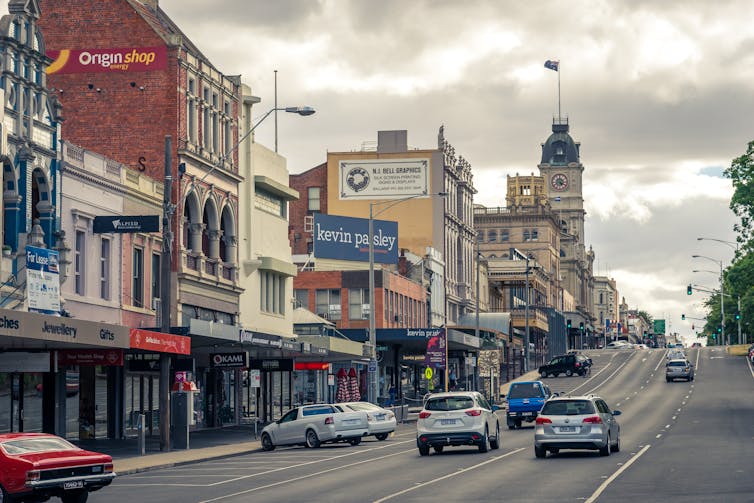Source: The Conversation (Au and NZ) – By James Graham, Lecturer in Economics, University of Sydney

As home ownership moves further out of reach for many Australians, “rentvesting” is being touted as a lifesaver.
Rentvesting is the practice of renting one property to live in yourself, while simultaneously purchasing an investment property somewhere cheaper and leasing it out.
Ideally, “rentvestors” get to enjoy the capital gains on an investment property while living where they actually want to live, allowing them to cash in and upsize to their dream home later.
It might seem like a savvy way to game the property market. But what are the risks of such an investment strategy? And how might broad adoption of this behaviour affect housing affordability in Australia?
A rising tide lifts all boats differently
The aim of the rentvesting game is to buy cheap property now, ride the expected capital gains, and move into a more desirable home down the track. The hope is that by climbing the first rung of the property ladder early, the whole thing won’t be pulled up out of reach.
The first problem with this strategy, however, is that capital gains on housing are not always and everywhere equal.
Generally, the cheapest properties available to rentvestors will be houses in the regions or apartments in the city. But both regional housing and apartment properties tend to appreciate more slowly than the inner-city houses rentvestors might hope to live in one day. They might get a foot on the property ladder, but the rungs themselves are slowly drifting apart.

Steve Tritton/Shutterstock
Would-be rentvestors should also be aware that investments by “out-of-town” buyers tend to generate much lower returns – both capital gains and rental yields – than investments by locals. Out-of-towners don’t know the local market trends, don’t know which neighbourhoods to avoid, and aren’t able to monitor their investments as effectively from afar.
Avoiding the regions by investing in city apartments presents its own difficulties. Large, unexpected maintenance bills and poor strata management are common complaints.
Different costs lead to different returns
Perhaps the potential rentvestor should invest in something more straightforward instead, like stocks. After all, the return on equities in Australia has outperformed housing in recent decades.
However, it is much easier to borrow to invest in property than it is to borrow to invest in the stock market. And leverage is the investor’s secret weapon. For example, if house prices were to appreciate at 10% per year, then using a mortgage and a A$100,000 deposit on a $1 million property would earn you a 100% return on equity before costs.
But while both investors and homeowners would earn that same basic return, their costs could be very different. For starters, property investors face capital gains tax on the proceeds of property sales, unlike those selling their primary residence. Banks also typically charge higher interest rates on mortgages to investors than to homeowners.
At times, the Australian Prudential Regulation Authority has also imposed caps on bank lending against investment properties, making it more difficult to find mortgage financing in the first place.
Highly leveraged properties require mortgage insurance, too. Investors may need to take out larger insurance policies against the properties themselves, reflecting the higher risks associated with investment properties. Then, you also have to throw in property management fees, council rates, strata management fees and regular and unexpected maintenance costs.
Negative gearing offers little benefit
What about negative gearing? Property investors that generate losses on their property can deduct these costs against the tax bill on their other income.
But negative gearing disproportionately benefits high-income earners with large tax bills. The median Australian individual income is around $55,00, which generates a tax bill of about $8,000 – not a lot from which investment property losses can be deducted.
The bigger picture is that while negative gearing helps defray the regular costs of managing a property, it doesn’t do anything to change expected capital gains.
At the end of the spreadsheet tally, an investment property could end up earning rentvestors significantly less than they could have gained by simply buying their first home.
Read more:
What is negative gearing and what is it doing to housing affordability?
Effects on housing affordability
Rentvesting is new enough that its prevalence and influence awaits formal academic study. But economists might speculate about its implications for the housing market more broadly.
The simplest analysis suggests that a rentvestor occupies one rental property while supplying an additional rental property to the market. If, instead, they had bought a home, they would vacate a rental property while removing another property from the market. In this case, even rentvesting en masse would have zero net effect on the housing market.
But a more nuanced perspective might consider where rentvestors are renting and where they are investing. Perhaps they are most likely to rent properties in the already-crowded inner city, but purchase investment properties in regional areas where other first home buyers would like to live.
This would increase demand for rentals in the city and reduce the supply of owner-occupier properties in the regions, worsening the affordability of both.

Alex Cimbal/Shutterstock
Of course, if these rentvestors all eventually move up the property ladder – selling in the region and purchasing in the city – this effect would be reversed. From that longer-term perspective, rentvestors would ultimately have little effect.
We still need more houses
Rentvesting is not a panacea for Australia’s housing market woes. Potential investors should weigh the benefits of property investment against its substantial costs and risks. Additionally, they need to carefully consider the obvious alternative: simply buying their first home up-front.
We have good reason to be wary of yet another get-rich-quick scheme involving the housing market. But initial considerations suggest that for the market overall, rentvestor behaviour is no worse than someone simply buying their first home, which we would otherwise encourage.
Rather than criticising those seeking a way though our housing market morass, we might instead redouble our efforts to increase the supply of housing.
![]()
James Graham has received research grant funding from the Australian Housing Research Institute. He is currently the Editor-in-Chief of the academic journal New Zealand Economic Papers.
– ref. Becoming a landlord while still renting? ‘Rentvesting’ promises a foot on the property ladder, but watch your step – https://theconversation.com/becoming-a-landlord-while-still-renting-rentvesting-promises-a-foot-on-the-property-ladder-but-watch-your-step-229116







